Climate Considerations
Choosing the right hibiscus starts with understanding your local climate and the specific cold hardiness or heat tolerance needed.
Tropical Hibiscus
- Climate Adaptability: It is best suited to warm, humid environments typical of tropical climates. It does not tolerate cold well and can be severely damaged by frost.
- USDA Hardiness Zones: It is hardy in USDA zones 10 to 12. In these zones, it can be grown outdoors year-round. In cooler zones, it should be treated as a container plant that is moved indoors during colder months to protect it from freezing temperatures.
Rose of Sharon
- Climate Adaptability: Rose of Sharon is notably hardier than tropical hibiscus and can tolerate a wider range of temperatures, including cold winters. It is quite adaptable and can withstand brief periods of drought once established.
- USDA Hardiness Zones: Rose of Sharon is hardy in USDA zones 5 to 9, making it suitable for a broad swath of climates across much of the United States. It’s an excellent choice for gardeners who want a hibiscus that can handle colder conditions.
Hardy hibiscus
- Climate Adaptability: As its name suggests, hardy hibiscus is robust and can survive in colder climates where other hibiscus species would fail. It dies back to the ground in winter and re-sprouts in spring.
- USDA Hardiness Zones: It is suitable for USDA zones 4 through 9. This makes it one of the most cold-tolerant hibiscus species, capable of thriving in areas with harsh winters and returning year after year.
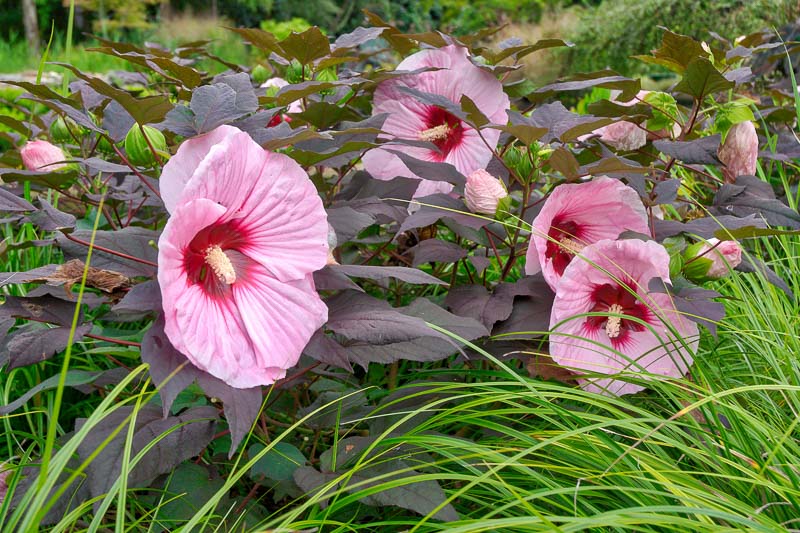 Hibiscus ‘Kopper King’
Hibiscus ‘Kopper King’
Soil and Sunlight Requirements
Hibiscus vary in their soil and sunlight requirements depending on the species. Understanding these needs is essential for successful cultivation.
Tropical Hibiscus
- Soil: It thrives in well-draining, neutral to slightly acidic soil. The soil should be rich in organic matter to retain moisture while allowing excess water to drain quickly, avoiding waterlogged conditions which can lead to root rot.
- Sunlight: This variety requires full sun to bloom profusely. It should receive at least 6 to 8 hours of direct sunlight daily. In extremely hot climates, some afternoon shade can help prevent leaf scorch, but generally, the more sun, the better the blooms.
Rose of Sharon
- Soil: Rose of Sharon is less picky about soil pH and can thrive in a range from slightly acidic to slightly alkaline. Like tropical hibiscus, it prefers well-draining soil but is more adaptable to different soil types, including clay soils, as long as they are not prone to standing water.
- Sunlight: It performs best in full sun to light shade, needing at least 6 hours of direct sunlight to ensure vigorous growth and abundant flowering. However, it can also tolerate partial shade, especially in hotter regions, though too much shade will reduce flowering.
Hardy hibiscus
- Soil: It prefers average, moist, organically rich soils and can be grown in standing water, up to 6 in. (15 cm) deep.
- Sunlight: This species requires full sun to bloom best, with at least 6 hours of direct sunlight daily. Like Rose of Sharon, it can manage in partial shade, but its blooming might be less prolific. In cooler summer climates, maximizing sun exposure helps enhance flowering.
Conclusion
- Soil Adaptability: Of the three, Rose of Sharon is the most adaptable to various soil types, followed by Hardy hibiscus. Tropical hibiscus has the most specific soil requirements, particularly regarding drainage and acidity.
- Sunlight Tolerance: All three species bloom best in full sun but have varying degrees of shade tolerance. Tropical hibiscus is the least tolerant of shade, requiring a full sun position to truly thrive and bloom well. Rose of Sharon and Hardy hibiscus can handle some partial shade, making them slightly more versatile in landscape design.
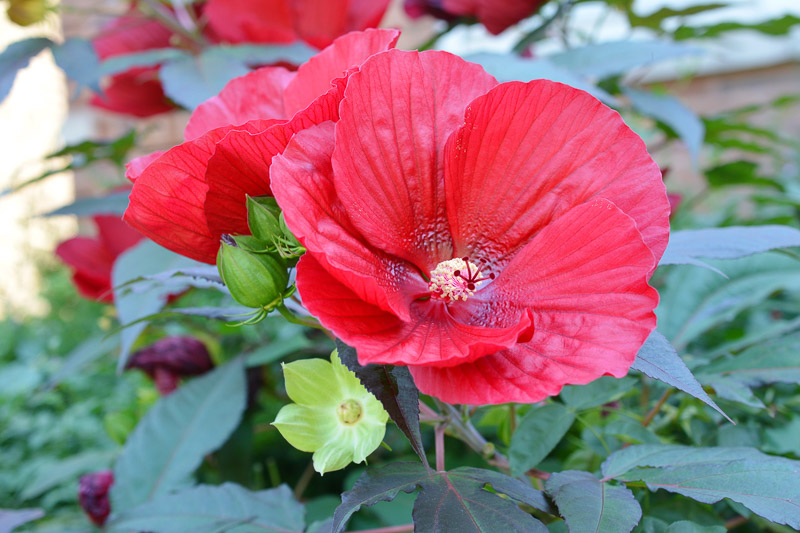 Hibiscus moscheutos ‘Luna Red’
Hibiscus moscheutos ‘Luna Red’
Water and Fertilization
Water and fertilization are critical aspects of growing healthy hibiscus plants, though requirements can vary significantly among hibiscus varieties.
Tropical Hibiscus
- Watering: Tropical hibiscus requires consistent moisture and should be watered frequently, especially during hot, dry periods. The soil should be kept evenly moist but not soggy. Allow the top inch of the soil to dry out slightly between waterings to prevent overwatering and root rot.
- Fertilization: This species benefits from regular feeding with a high-potassium fertilizer to encourage blooming. During the growing season (spring through fall), fertilize every two weeks with a water-soluble hibiscus fertilizer or a similar formulation. Reduce feeding in the winter when growth slows.
Rose of Sharon
- Watering: Rose of Sharon is more drought-tolerant than tropical hibiscus. It prefers regular watering but can tolerate periods of dryness once established. Watering should be consistent to promote healthy growth and flowering, particularly in the first few years and during prolonged dry spells.
- Fertilization: Rose of Sharon does not require as frequent fertilization as tropical hibiscus. An annual application of a balanced, slow-release fertilizer in early spring is typically sufficient. Over-fertilization can lead to excessive leaf growth at the expense of flowers.
Hardy hibiscus
- Watering: Hardy hibiscus thrives in moist conditions and even tolerates wet soils, making it ideal for waterside plantings. Regular, deep watering is important, especially during blooming and dry conditions. The soil should never dry out completely.
- Fertilization: Like tropical hibiscus, hardy hibiscus benefits from regular fertilization during the growing season. Apply a balanced fertilizer monthly from early spring until late summer to support its vigorous growth and large blooms. Stop fertilizing as fall approaches to allow the plant to prepare for winter.
Conclusion
- Water Sensitivity: Tropical hibiscus is the most sensitive to overwatering and under-watering, needing a perfect balance to thrive. Hardy hibiscus is the most water-loving, often found naturally in wet environments.
- Fertilization Needs: Tropical and hardy hibiscus require more frequent feeding compared to Rose of Sharon, reflecting their more substantial blooming and growth demands. Hardy and tropical varieties particularly benefit from high-potassium fertilizers to enhance bloom quality and frequency.
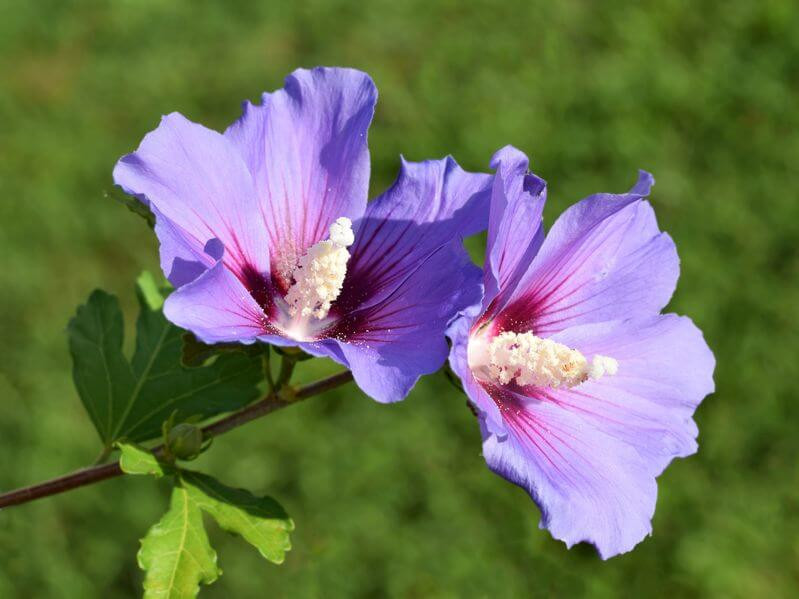 Hibiscus syriacus ‘Oiseau Bleu’
Hibiscus syriacus ‘Oiseau Bleu’
Design and Display
When designing a garden or arranging displays with hibiscus plants, understanding their unique characteristics will help you maximize their visual impact.
Tropical Hibiscus
- Visual Appeal: Tropical hibiscus is renowned for its vivid, glossy, and often multi-colored blooms that can transform any space into a tropical paradise. The flowers come in various shades, including red, orange, yellow, pink, and combinations thereof, making them stand out in any floral display.
- Garden Design: Ideal for creating a tropical look, tropical hibiscus works well in container gardens, as standalone potted plants on patios or balconies, or integrated into mixed borders with other tropical-style foliage plants. In frost-free zones, they can be planted directly in the ground to form colorful hedges or accent plants.
Rose of Sharon
- Visual Appeal: Rose of Sharon offers a different aesthetic with its later blooming period, typically from mid-summer to early fall. The flowers are less tropical-looking but come in a range of pastel colors, including blue, pink, lavender, and white, often with a contrasting eye.
- Garden Design: This hibiscus species is more versatile in temperate garden designs. It can be used as a hedge, privacy screen, or as part of a shrub border. Rose of Sharon is particularly effective when planted in groups or rows and can be trained into a small tree, adding height and structure to garden designs.
Hardy hibiscus
- Visual Appeal: Hardy hibiscus is famous for its large, eye-catching blooms, which can be as large as a dinner plate. The flowers are typically in shades of white, pink, red, or burgundy and often feature a darker red center.
- Garden Design: Thanks to its robust size and dramatic flowers, hardy hibiscus is perfect for use as a focal point in garden beds and borders. It pairs well with other perennials that enjoy similar wet conditions, such as irises and ferns. In landscape design, hardy hibiscus can be used in rain gardens, along pond edges, or in large containers where its striking flowers can be displayed prominently.
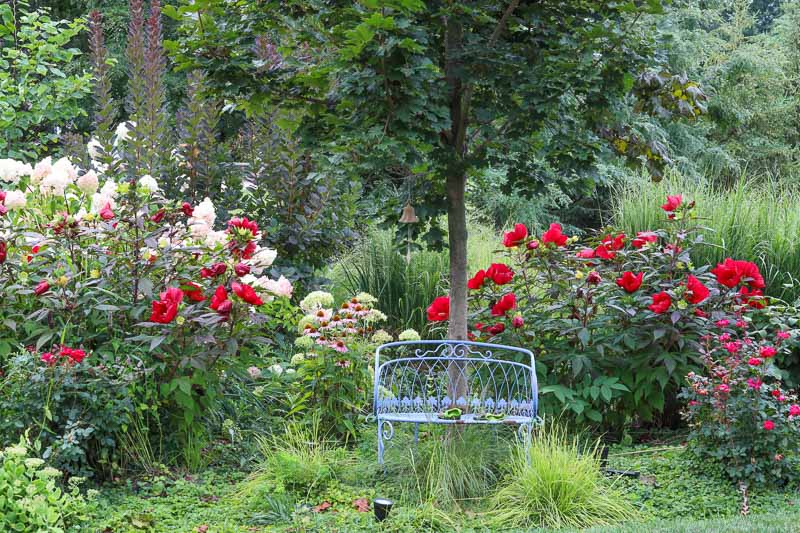
Container Growing
Growing hibiscus plants in containers offers a versatile way to cultivate these vibrant bloomers, especially when garden space is limited or climatic conditions are not ideal for ground planting.
Tropical Hibiscus
- Container Suitability: Excellent for containers due to its preference for warm, controlled environments. Container growing allows for easy movement indoors during colder months in temperate climates.
- Potting Mix: Use a well-draining, slightly acidic potting mix rich in organic matter. A mixture of peat, compost, and perlite or vermiculite works well.
Rose of Sharon
- Container Suitability: Adaptable to containers but can grow quite large, so it requires a sizable pot to accommodate its root system and ensure stability.
- Potting Mix: Benefits from a general-purpose potting mix that holds moisture yet drains well. Incorporate compost for added nutrients.
Hardy Hibiscus
- Container Suitability: Suitable for large containers given its size and fast growth.
- Potting Mix: Prefers a moisture-retentive, well-draining potting mix. Mixes designed for pond plants or with higher peat content are ideal.
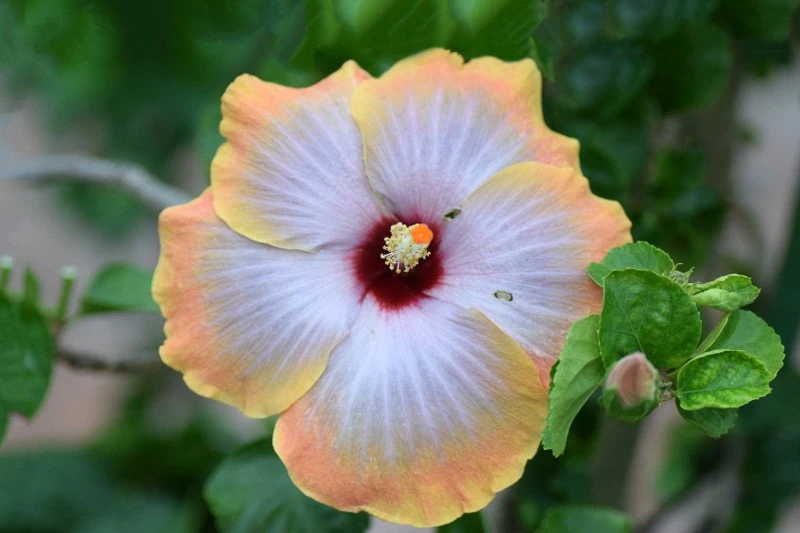 Hibiscus rosa-sinensis ‘Fifth Dimension’
Hibiscus rosa-sinensis ‘Fifth Dimension’
Pollinators and Wildlife
Selecting a hibiscus can also impact local wildlife. Hibiscus flowers are known for attracting pollinators like bees and hummingbirds, adding an extra layer of life to your garden. It is important to note that hibiscus flowers are not toxic to cats and dogs.
Choosing native hibiscus varieties for your garden can significantly benefit local ecosystems by providing essential habitat and food sources for native wildlife, including pollinators and birds.
In the United States, native hibiscus species are particularly valuable for their ecological roles and natural beauty.
Habitat: This species is typically found in wetlands and along riverbanks across the Eastern and Southern United States.
Wildlife Benefits: The large, showy flowers of the swamp rose mallow are especially attractive to bees and hummingbirds, which are primary pollinators. The dense foliage also provides shelter for small wildlife and supports beneficial insects.
Habitat: Similar to H. moscheutos, H. laevis is native to wetlands and river margins but is more widespread across the central and southeastern U.S.
Wildlife Benefits: Its flowers attract a diverse array of pollinators including butterflies, bees, and hummingbirds, playing a crucial role in the pollination process. The plant’s structure provides nesting sites and cover for various small animals and birds.
Habitat: This species is native to the wetlands and swampy areas of the Southeastern U.S., particularly in Florida.
Wildlife Benefits: Similar to other native hibiscuses, it serves as a nectar source for butterflies and hummingbirds.